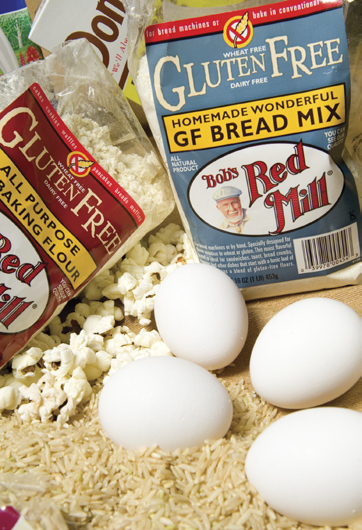For some athletes, eliminating gluten could enhance performance. Athletes know that diet can affect performance – it’s the reason we opt for pure, not processed, and fruit, not fries. But could carbo-loading be keeping you down? If you’re feeling low after filling up on pasta or cereal, you could have a form of gluten intolerance.
Gluten and Celiac Disease
Gluten is a particle found in wheat, barley and rye. Salad dressings, soy sauce, processed lunch meats and other products may contain “hidden” gluten that acts as a filler. Most Americans can stomach gluten without a problem, but for some, the particle can cause health problems and hinder athletic performance. About one in 133 Americans suffers from celiac disease, an autoimmune disorder triggered by eating gluten. Of the estimated 3 million Americans with celiac disease, 95 percent don’t know they have it. A larger percentage of the U.S. population is suspected to suffer from gluten sensitivity. For athletes, that could make any activity an uphill battle.
Impact of Gluten on Performance
For those with celiac disease, eating gluten leads to inflammation and intestinal damage. As a result, nutrients are not properly absorbed. This negatively impacts:
• Ability to recover after a training session
• Healing time from injury or illness
Other potential effects include:
• Electrolyte imbalance, potential cramping, and muscle fatigue
• Joint pain
• Sensitivity to bruising
• Anemia, which can cause fatigue
The Gluten-Free Diet
Currently, the only treatment for celiac disease is a lifelong gluten-free diet. It’s a challenge, but many athletes report noticeable improvements in health and performance after they give gluten the boot. A simple trick for eliminating gluten is to focus on naturally gluten-free whole foods. If it had legs and/or fins, grew from the ground or a tree, then it should be safe. Examples include meat, poultry, fish, potato, rice, vegetables, fruit, and healthy fats like coconut oil, olive oil and nuts. Note: If you believe you may have celiac disease, it’s important to get a blood test (and potentially, a biopsy) before starting a gluten-free diet. Ask your primary care physician for a referral to a gastroenterologist.
Gluten-Free Snack Ideas
• Apple and string cheese – very portable, easy and tasty.
• Celery sticks and natural peanut butter with a small container of cottage cheese or Greek yogurt. Try to get the plain kind; the flavors add a lot of sugar. Most grocery stores now carry Greek yogurt – it’s thicker and creamier than regular yogurt, with higher protein content.
• Deli turkey slices (Boar’s Head brand is a common gluten-free option) wrapped around baby carrots.
• Small handful of almonds with a piece of fruit and hardboiled egg
• Sliced bell peppers dipped in hummus or bean dip (To make your own, combine a can of white or garbanzo beans in a food processor with some garlic, thyme, sea salt and a tiny drizzle of olive oil).
• Small can of tuna and celery or carrot sticks, with a small handful of nuts.
• Plain Greek yogurt with berries and sliced almonds or crushed walnuts.
• Cottage cheese with a piece of fruit or chopped veggies.
• Jerky (check for a gluten-free brand) and apple. High in protein and no refrigeration needed.
• A protein shake with a handful of almonds and an apple. Protein powder only requires some water and a bottle to shake-and-go.






